Around The World in 11 Pinots
POSTED ON 16/05/2011This is a summary of the talk I gave at the Decanter New World Fine Wine Encounter on Saturday
Preparing this talk, I came across the reports of two tastings in which a New World pinot noir had blitzed the Domaine de la Romanée-Conti. The first was a Martinborough Vineyard Pinot Noir 1998 Reserve which trumped 19 other wines including a $7000 bottle of 1990 La Tâche at a blind tasting in California. Then I discovered that in 2004, Domaine Serene had (in its words) ‘shocked the wine community’ by beating DRC (not sure which) in a blind tasting of three wines from each producer in vintages 1998, 1999, and 2000.
These comparative blind tastings all hark back to the granddaddy of them all, the Judgment of Paris, led by the evergreen Steven Spurrier in 1976. And what they tell us is that whatever the reasons for the results, and however much the true test of the value of a wine is decided by the market rather than blind tastings, we now know that at the highest level the New World is force to be reckoned with, whether with cabernet sauvignon, with malbec, or as the two reports suggest, with pinot noir.
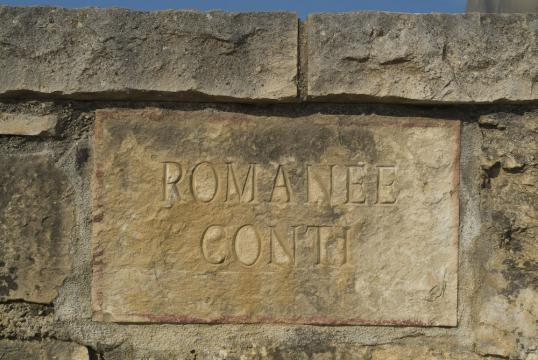 Holy Grail
Holy Grail
The story of New World pinot noir begins of course, in that strip of earth known as the Côte d'Or or ‘Slope of Gold’ in Burgundy. Early one morning, I was treated to a balloon flight over the Côte d'Or and it was a revelation. Floating over the frozen tidal wave that houses all the great names, such as Gevrey Chambertin, Clos Vougeot, Morey Saint Denis, Nuits St.Georges, Chambolle Musigny, not forgetting of course Vosne Romanée, you could see how the topography of Burgundy worked, and not just for its marginal climate.
Hovering a few hundred feet in the air, invisible dogs barking in the pale dawn light below, you could make out the contours of the land, the east and south-east-facing slopes and how the bottom of the slope is flat and not that well-drained, how the top is too high, steep and wooded, and how the middle contains that tenderloin of well-ventilated, well-drained gently sloping vineyard land that houses the great premiers and grands crus of Burgundy.
Mind you, even seeing the topography in that way doesn’t explain how for instance in one grand cru such as Clos Vougeot there are so many different growers and so much disparity in style and quality. To a certain extent it’s down to the lie of the land, but equally the interpretation of the pinot noir grape even within such a small plot of vineyard can vary enormously according to philosophy, to savoir faire and to the commitment of time, energy and money invested in the job.
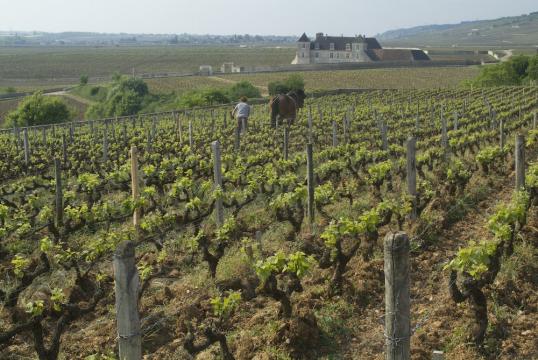 Clos Vougeot in the distance
Clos Vougeot in the distance
I remember when I was interviewing Burgundy’s favourite son, Henri Jayer, for a profile I was writing, asking him what percentage of a wine’s quality and character he attributed to the soil and climate and what to human endeavour. Expecting the answer 90%:10%, instead I was told 50:50. Perhaps even more than the results of comparative blind tastings, Henri Jayer’s words would have been music to the ears of aspiring New World producers of pinot noir.
Pinot noir is legendary for its capriciousness, hence its moniker as ‘the heartbreak grape’, ‘a minx of a vine’ and the many other exasperated expletives no doubt uttered in every vintage by producers – not to mention consumers - around the globe
What is pinot noir? It’s an early-ripening vine variety, so it thrives only in the cooler vineyard locations of the globe where the growing season is long enough for flavour to develop. It’s ironic in that context that warm summers in 2003 and 2009 in Burgundy have produced pinots that some would say were atypical for the overgenerosity of fruit and flavour.
In the New World you might say, broadly speaking, that New Zealand and Oregon have the edge because despite the fact that they can undergo hot summers, they are on roughly similar latitudes for pinot with marginal or maritime climates. Australian pinot flourishes in the Ocean-cooled viticultural regions such as Tasmania and the cooler reaches of Victoria. Californian Pinot Noir grows best in locations normally shrouded in coastal fogs and cooled by ocean breezes. Ditto South Africa at Walker Bay right down south at the Atlantic tip of the African continent and Chile, with the southern Chilean wine region of Bío Bío its potential answer to new Zealand’s Central Otago.
It’s almost a cliché these days to talk about pinot noir as The Holy Grail. Since Sideways, the issue arises as to whether the red Burgundy grape today has become, in a question posed by Jancis Robinson after a blind tasting last year of pinot noirs from 5 different New World regions (Australia, California, Chile, New Zealand and Oregon) ‘almost boringly mainstream’? The world's best sommelier, Gérard Basset, told her that he now hesitates to recommend the red burgundy grape, once the safe choice for a party with a wide range of main courses, 'as it has become too predictable'.
One of the interesting things about red Burgundy of course is the hit rate of really top-notch pinot noirs and herein lies the problem. Because when you see the mad dash of consumers for the latest en primeur Burgundy vintage, they are not looking to buy common-or-garden négociant red Burgundy. In 97.5% of cases they are looking to buy red Burgundy made by small growers in small quantities. Small, in other words, is beautiful.
For that reason, and because pinot noir is such a capricious variety, bending and wavering according to the vagaries of the weather and enormously fussy about where it’s planted and how it’s treated, it’s tended to be the province of small growers in the New World too. Put simply, there’s too much commercial risk involved in trying to grow pinot noir on a commercial scale.
This dichotomy between really great Burgundy and the majority of rarther ordinary village pinot noir is precisely what’s given the New World the spur to say ‘anything you can do we can do better’. On the one hand that is, to create something of higher quality and value than your average run-of-the-mill red Burgundy, and on the other to aspire to the elegance and intensity of the great premiers and grands crus of Burgundy.
So now I come on to today’s selection of New World pinot noir. What I’ve tried to do is to give a certain weighting to the two regions outside Burgundy perhaps best know for their pinot noirs, hence an emphasis to an extent on New Zealand and Oregon. At the same time, I’ve aimed at as varied a selection as possible to the table here and my one regret is not having the Argentinian pinot noir from Chacras in Patagonia.
This to my mind is Argentina’s best expression of pinot noir and brings hope for the future of pinot across the Andes from Chile. At the same time, rathar than simply showcase growers, we have at least two big company pinots here, from Chile and New Zealand, to illustrate the point, hopefully, that consistency in pinot noir is perhaps more easily achievable in the New World than it is in Burgundy itself.
(Thanks by the way to the various wineries involved for their technical and other info, which I have used liberally throughout this talk)
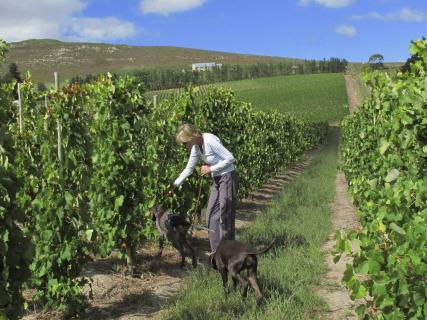 Newton Johnson
Newton Johnson
Part 2 – South Africa and Chile
1. 2009 Newton Johnson Pinot Noir, Upper Hemel-en-Aarde Valley, South Africa
£18-£18.50 Bibendum, SA Wines Online
This is the second vintage of Pinot Noir from the Newton Johnson property in the Upper Hemel-en-Aarde Valley following earlier vintages in the Hemel-en-Aarde Valley (’00-’03) and Elgin (’04 onwards). They claim that it ‘disperses the notion of a varietal wine, and shows there is much more diversity to discover in their various vineyard sites and the factors that have influence’.
100% Upper Hemel-en-Aarde Valley, the vineyard faces and the soils are eroded sandstone and quartz from the mountain slopes above, overlying a red clay horizon at varying depths which has developed from weathered granite with a middle horizon of 50% gravel is also largely present in the soils. Vines are 8 years old at 2857 – 5000 per hectare and the average yield 2.5 – 5 tons/Ha (16 – 32 hl/Ha).
Analysis Alcohol by volume 13.67%
Total Acidity 5.3 g/l
pH 3.76
Residual sugar 2.0 g/l
In the 2009 vintage, budbreak was very late after one of the coldest winters experienced in the last 5 years and the growing season right up until January was perfectly temperate (similar to 1997), with cool days and much lengthened ripening. The last 10 days of February saw more extreme temperatures and some intense heat waves but overall the fruit arrived in a very good condition.
The wine is made by Gordon Johnson. The fruit is harvested by hand and cooled down overnight to 8ºC in the winery’s grape refrigeration room. The bunches are sorted on a conveyor, destemmed, berry sorted by hand again, and crushed (60% whole berry). All transfers of grape must are attained with the use of gravity. Cold maceration ensues for 3 to 6 days. The primary and malolactic fermentation is 100% indigenous, only pigeage (punching down) is applied for extraction. After pressing the wine is racked and left to complete its malolactic fermentation and is 100% matured in barriques (228L) for 11 months using a blend of Burgundy cooperages at 28% new oak.
Tasting Note:
Pale in colour, this is lightly minty / sagey on the nose with light simple cherryish fruit , a hint of tomato skin, and a delicate layer of lightly toasted oak, soft tannins and a savoury finish; there’s a young vine feel to it because the berry fruit lacks a little concentration on the mid-palate, and this factor, combined with its relatively moderate alcohol at 13.5%, gives it a sort of village Burgundy feel.
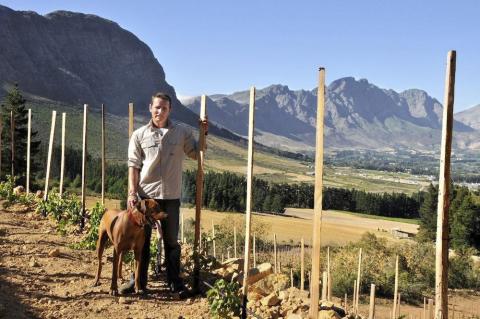 Chamonix
Chamonix
2. 2009 Chamonix Pinot Noir Reserve, Franschhoek, South Africa
£14.12, Uncorked
Formerly part of historic La Cotte granted to the Huguenots in 1688, Chamonix Wine Farm nestles against Mont Rochelle mountain in Franschhoek in the Western Cape, and comprises some 300 hectares. German-born Chris Hellinger, entrepreneur and big game hunter, acquired the farm in the early nineties when it was predominantly an export fruit farm. He steadily replaced fruit trees with French varieties and an underground cellar was built.
Chamonix has around 50 hectares under vineyard, using only estate grapes. The farm benefits from cool breezes during the hot summer months while vines are mainly dry-land, their roots reaching down deep into the stony, clay-rich soil. Green-harvesting helps to keep the yields down and Chamonix is moving from conventional farming methods to more environmentally friendly viticulture by not using pesticides and chemicals, and using organic compost and mulch which is worked back into the soil.
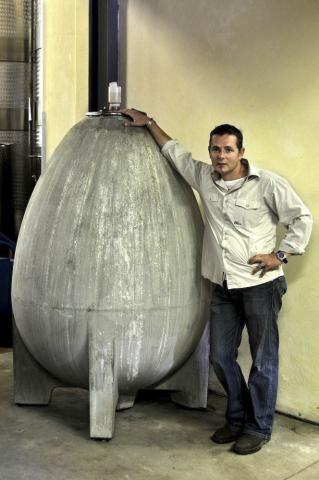 Gottfried Mocke and egg tank
Gottfried Mocke and egg tank
Winemaker Gottfried Mocke is primarily responsible for the vineyards, and together with Werner Muller they are assisted by Daniel Nel and William Jiemies in the Cellar. All fruit is hand-selected and harvested at a yield of about 4 tons per hectare. Grapes come from four parcels totaling six hectares ranging from 450 to 600 metres of altitude on slopes facing south-southwest. The vines of an average age of 15 years are planted on medium-packed calcareous clay soils. Planted in a density of 4800 vines per hectare and trained in the traditional Cordon system.
After the grapes are destemmed, the must is fermented in wooden and concrete vats with spontaneous yeast at a maximum temperature of 30° C for no more than 18 days on the skins, with frequent punchdowns of the cap. Malolactic fermentation occurs naturally and the wine is matured for 15-16 months in 228 litre French Allier oak, with approximately 60% new oak. The wine, of about 13.5% alcohol, receives a light egg-white fining before bottling.
Tasting Note:
The Chamonix Pinot Noir Reserve displays a ruby red colour, with aromatic notes of cherry and wild berry, a touch of pepper and spice. It’s quite a firmly extracted style showing the backbone of tannins on the back palate while the acidity, which is said to be natural, is perky and quite marked.
3. 2008 Cono Sur 20 Barrels Pinot Noir, Casablanca, Chile
£19.99, Morrisons
Viña Cono Sur was founded in 1993 . The name Cono Sur refers not to you or me but to the southern cone shape of the South American continent. The winery has established its reputation through its pinot noirs which it makes in a range of four different levels starting with the staright Cono Sur all the way up to Ocio at the highest level.
Pinot Noir was chosen as the first of the 20 Barrels portfolio to be developed due to the commitment of head winemaker, Adolfo Hurtado, towards developing pinot noir varietal in Chile. Grapes come from 521 different estates throughout Chile including Colchagua, Bío Bío, Casablanca, Limarí, Maipo and San Antonio. In 2007, Cono Sur crushed 3.8 million kilos of pinot, which equals around 270,000 cases of pinot noir, making it the biggest producer of pinot noir in the world.
The wine comes from the El Triangulo Estate, Casablanca Valley (90%) and Lo Ovalle Estate (10%) where the soils are sandy and rich in minerals and red clay. The climate is cool with cool nights and foggy mornings and the vineyard structured to vertical trellis system, drip irrigation and integrated management. Manual harvest was on the 20th March with a yield of 6 tonnes per hectare. Grapes were 100% destemmed with cold maceration at 8 °C for 5 days, cultured yeast, followed by fermentation for 6 days at 27 °C in open top stainless steel fermenters. The wine was aged for 12 months in 100% new French oak barrels. 13.6%. 3.3 ph. 2.3 r/s.
The plan is to increase the organic side. According to Hurtado, in an interview in 2007, “This is another sector in which we’re seeing substantial growth. It’s not easy, especially regarding botrytis problem. You reduce a lot of crop compared with conventional. You need to be mentally prepared to go into biodynamics. Because it has a lot of sense, you can understand the how and why but it’s like a religion, you need to trust a lot of things and I think Cono Sur is too busy trying to grow but maybe one day when more set up we may move some production into biodynamics”.
Tasting Note:
Dark in appearance with a beautiful clean and bright ruby red colour, 20 Barrels Pinot Noir displays black fruits notes of dark cherry, ripe strawberry, and plum with a veneer of toasty oak. The wine is sweetly ripe and opulently plummy on the palate with the oak nicely integrated and adding a polished sheen to the fruit. Overall, while on the riper, sweeter, darker style, it holds its balance well.
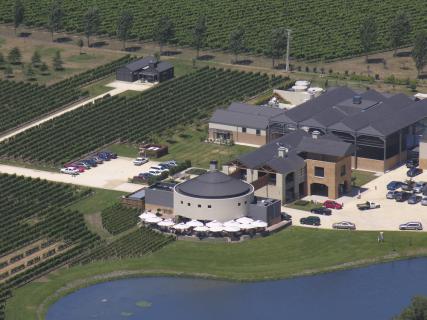 Craggy Range
Craggy Range
Part 3 – New Zealand and Australia
4. 2009 Craggy Range Te Muna Road Vineyard Pinot Noir, Martinborough, New Zealand
£19.99, Waitrose
Martinborough is located in the 100 km long Wairarapa Valley, wide open to the Southern Ocean with nothing much between it and Antarctica. It is flanked by mountain ranges on both east and west which creates a strong rain shadow effect; at 700 mm pa Martinborough has the lowest rainfall in the North Island. Drying north-westerly winds are also common, so disease pressure is very low.
Cold wind and frosts during spring flowering frequently impact on yield. The region accounts for just 2.7% of New Zealand’s planted area, but a tiny 1.6% of wine by volume. The Martinborough Terrace on the village’s northern side is made up of shallow silt-loam over 25 metre deep, very free draining alluvial gravels.
Lying in the shadow of the wild craggy range,Te Mata peak, this prestigious Hawkes Bay winery was started by a partnership between Terry Peabody and his family and viticulturalist Steve Smith MW. Their aim was to make single-vineyard wines from the best New Zealand vineyards.
The 2009 growing season was a very strong one for the Te Muna Road vineyard. Winter and early spring rains set up the season. A long and hard period of successful frost fighting filtered water down deep in the soil. The old weathered gravels of the upper terrace at Te Muna have the capacity to hold the moisture, allowing them to successfully farm pinot noir without irrigation for the 2009 season. Harvest began in late March and intensified in early to mid April. Fruit condition was excellent, small berries with just a hint of shrivel, lower than average acidity and ripe powdery tannins.
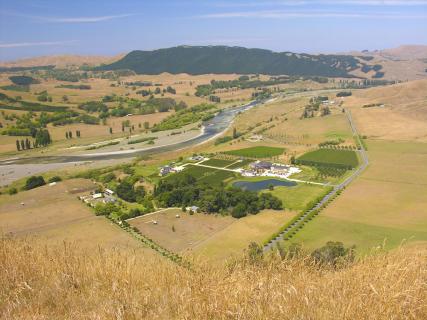 Craggy Range
Craggy Range
Analysis:
100% pinot noir planted on upper Martinborough Terrace with unique rock and soil formation. The best clusters were left at thinning time. Densely planted with 115, 667 and 777 clones on low-vigour rootstocks. Hand-harvested, chilled overnight, sorted, destemmed into tank with 5% whole clusters. 8-17 day cold soak, each of different parcels batch-fermented with indigenous yeast. Hand-plunged then transferred direct to French oak barriques post ferment for 10 months (32% new). Unfined and lightly filtered. Winemaker Steve Smith MW and Adrian Baker.
Alc 14.4%, TA 5.6g/l, pH 3.52. 27 hl/ha average . 5% whole bunch 95% destemmed. Open top oak tanks . Indigenous yeast . French oak barriques 32% new 10 months .
Tasting note:
Aromatic with bright red fruits and good ripe cherry, red berries and spicy pinot noir fruit quality with quite firm backbone of tannin and acidity, but deliciously rich, full-bodied and fruity, with refreshing acidity and quite muscular tannins but nothing wrong with that in the context of a broad range of food such as game, lamb and salmon.
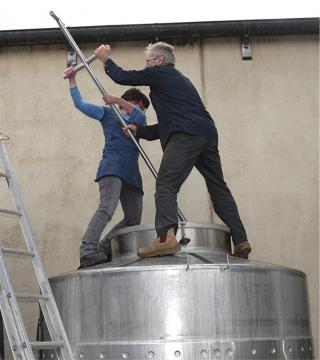 Ata Rangi
Ata Rangi
5. 2008 Ata Rangi Pinot Noir, Martinborough, New Zealand
£27.50, Liberty Wines / Independent Wine Merchants
Ata Rangi was planted by Clive Paton with his wife Phyll in 1980 at a time when Martinborough was a small, isolated rural service town. There was no hint of a wine culture back then, just dusty gravel roads, a couple of pubs, and the obligatory farm supply store. As one of a handful of people who pioneered the winegrowing area, Clive had farmed in the area and knew the land well. When he sold his herd of dairy cows in order to buy a lean, unproductive 12-acre paddock just a stone’s throw from the Martinborough Square, locals thought he’d lost the plot. But actully he’d found it.
He chose mainly red varieties and set out in pursuit of world-class wines. Clive was one of a handful of winemaking pioneers in the area, all attracted by a love of wine and three critical features of the area - the localised, free-draining shingle terrace some 20 metres deep, the lowest rainfall records of anywhere in the North Island, and the proximity to Wellington, just an hour away. Pinot noir’s potential shone from the start - the early wines widely appreciated for their texture and for their pure fruit expression of the variety. Clive's faith in the area paid off.
The original pinot noir came from Malcolm Abel, who, as a customs officer, had intercepted and confiscated the offspring of a single vine cutting allegedly taken by a traveller from Burgundy’s finest estate, Domaine de la Romanée-Conti , at Auckland airport. Malcolm Abel sent it to Te Kauwhata, the state-owned viticulture research station of the day, and duly planted the cuttings when they became available. Hence the name the Abel Clone, or Gumboot Clone, which remains at the heart of Ata Rangi Pinot Noir.
After miserable yields in 2007, flowering proceeded in superb conditions in late November/December and the typically severe nor-westers of early summer were largely absent. Fruit set was good with the region's usual compact bunches of small to moderate size resulting. The warm summer (slightly warmer then yearly average) and autumn drought provided perfect conditions for the developing grapes. Harvest itself was dry and sunny, and proceeded without a hitch from the last few days of March through to the end of April. Winemaker Helen Masters and vineyard manager Gerry Rotman are now in charge of wine production.
Says Clive: “We love the texture, and length of palate it delivers. Its tannins are substantial, yet are incredibly silky and fine. From our site, it brings dark cherry, and a brooding, savoury feel. Premium pinot needs the complexity that a range of clones brings. Ata Rangi has have over a dozen planted, with Clone 5/ Pomard also considered very valuable, giving the wine a solid mid-palate structure. It may not have the length of Abel, but brings wonderfully vibrant, aromatic fruit. The much feted Dijon Clones, selected by the research unit at Dijon University in the late 80’s, are less textural but have more front palate weight, and beautifully perfumed high notes”.
Tasting Note:
This is a gorgeous, seamless pinot noir, with good colour, expressively fresh fragrance and an immensly seductive raspberry fruit quality nicely etched by oak spice and an intensity of fruit that’s almost burgundian in its complexity and finesse. Young now, it should build secondary characters for good five years or more.
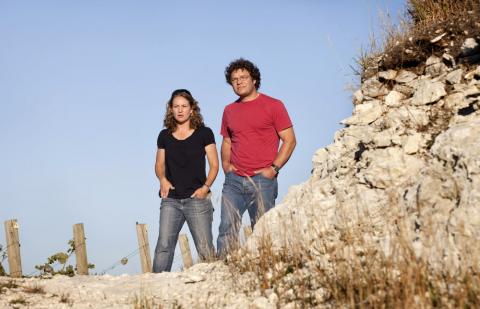 Marcel and Sherwyn, Bell Hill
Marcel and Sherwyn, Bell Hill
6. 2007 Bell Hill Pinot Noir, North Canterbury, New Zealand
Colchester Wine Company, poa
In a piece on Decanter.com on 11 April by Adam Lechmere, North Canterbury was said to be the centre of 'the finest Pinot Noir' in the southern hemisphere – according to wine critic Matthew Jukes. Bell Hill near Christchurch on the South Island, joined Ata Rangi, Felton Road and Mt Difficulty in the top rank of Matthew Jukes’ and Tyson Stelzer's list of 5-star New Zealand Pinots. Acccording to Jukes, Bell Hill, ‘is perfectly suited to making pinot noirs with freshness and minerality’.
The estate is owned by Marcel Giesen and Sherwin Veldhuizen. Located in in Waikari in the hills inland from the Waipara region near Christchurch, it’s unique in New Zealand in that the vineyard is based on limestone soil, and varies from green and brown clays to white pure chalky soil, at 270 metres in elevation. It’s a small scale operation with the aim of remaining small and producing at low yields of 2 tons/acre.
Marcel and Sherwyn were prepared to take the risk of a relatively unknown area and site and in fact their back-up plan was to make sparkling wine in case they couldn’t get the grapes ripe enough. First plantings were 1997 – 1999. They experimented with rootstocks and clones and ended up selecting mostly Dijon clones: 113, 114. 115. 667 and 777 and others. They were advised by terroir expert Claude Bourguignon who looked at the soils and gave the thumbs up.
Says Marcel: “The 2007 season started with a changeable spring with windy north-westerlies and southerlies. It followed the coldest June since 1972 and the windiest spring since 1975. It did not really warm up in early December at an average temperature of 4 degrees below normal until a heat spike arrived from the 17th. Weather during flowering was mixed –result was poor flowering over an elongated period, a lot of work was done in the vineyard with green harvesting. March and April brought warm stable weather only broken by the occasional coastal and southerly weather pattern. Yields were down although not to the extent of the 2005 vintage. Seven barrels of Pinot Noir were made and one barrel of Chardonnay”.
“The 2007 Bell Hill Pinot Noir is a 4 barrel selection, each of the blocks were harvested, fermented and aged in barrel separately. All of the Pinot Noir was de-stemmed and the wines stayed on skins for 28 days with approximately a week of cold maceration before ferment and a warm post-ferment maceration afterwards. The final blend comes from one barrel each of the Shelf and Quarry 10/5 upper portion of the block and two barrels of the Limeworks block, all of which were new French oak. This wine has an analysis of 13.4% alcohol, 5.3g/L TA and 3.68pH. Approximately 1,200 bottles were produced”.
Tasting note:
The wine is very concentrated with rich spicy aromatics and a core of dark cherry and plum fruitiness. Despite the concentration, the wine is intensly full-flavoured and elegant with a savoury, spicy fruit presence and appetising dry mineral feel; although still youthful it’s just starting to drink now but will keep for five years+.
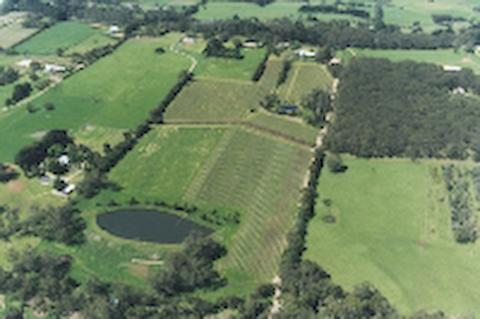 10 Minutes by Tractor
10 Minutes by Tractor
7. 2008 Ten Minutes by Tractor Judd Vineyard, Mornington Peninsula
Around £35, Great Western Wine, Bath
There is no department in which Australia takes kindly to being overshadowed by New Zealand, but in terms of pinot noir, recent efforts of the past five years have shown that Australia is starting to carve out a niche for itself in this most delicately poised of red wine styles. Cool climate is of course the key to pinot success in Australia, and as a result the most successful areas for the variety are in maritime Victoria and Tasmania.
The Mornington Peninsula is now well established in Australia as a premium boutique wine producing region for cool climate styles. The Peninsula has a cool maritime environment with a long ripening season allowing the development of rich yet elegant flavours. This cool climate is ameliorated by its proximity to water so it does not suffer from extremes such as spring or autumn frosts common to other cool climate areas. The Mornington Peninsula ripeness comes from its longer autumns.
In Mornington Peninsula’s red volcanic and grey sandy loam soils, the maritime influence helps to moderate temperatures , bringing power, plumpness and bright red fruit characters, redcurrant and raspberry in particular. Of particular interest to TMBT are the basaltic rocks extruded during the Tertiary period (55 to 33 million years ago) when basaltic lava flows were erupted over much of the eastern half of Victoria, covering fluvial gravel and sand deposits. Basalts weather relatively fast into relatively neutral and highly fertile red (due to iron oxide) loamy soils called ferrosols.
Ten Minutes by Tractor was formed in 1999 by three families (Wallis, Judd, McCutcheon), each of whom owned vineyards close to each other (in fact ten minutes by tractor apart) on the Mornington Peninsula. Their aim was to produce wines that reflected the unique character of their vineyard source and the subregion of Main Ridge. Ten Minutes by Tractor burst onto the scene in 2000 with several highly rated wines.
After the initial success, the three founding families found that producing and selling wine was demanding in terms of money, time and commitment and in 2004, Ten Minutes By Tractor was bought by Martin Spedding. In mid 2006 Ten Minutes By Tractor concluded the purchase of the McCutcheon vineyard from Andrew and Vivien McCutcheon and extended leasing arrangements on the other two original “home” vineyards, Wallis & Judd.
The key focus of Ten Minutes By Tractor is an unrelenting effort to grow the best fruit possible. This includes shoot thinning, shoot positioning, leaf plucking and cluster or bunch thinning, all by hand. The ultra premium blocks get low yields of around 3 tonne/ha (1.2 tonne/acre) for pinot noir. The winemaking philosophy is to be as non interventionist as possible and, for pinot noir and chardonnay, to use traditional Burgundian winemaking techniques. Winemakers are Richard McIntyre and Martin Spedding. Ten Minutes By Tractor now has 32.9 ha of vineyards including...22.9 ha Pinot Noir
The Judd Vineyard itself is on the due west facing slope of a valley running between the ridges of Main Creek and Purves Roads at an elevation of up to 206m in the east. First planted in 1990 (21 years old in 2011), this west facing vineyard experiences great afternoon and evening heat loads right up to the point of sunset and, for soil temperatures, into the evening. Partly due to this the Judd Vineyard is much more generous in the fruit flavour profiles which offers a unique point of difference from the elegance of Wallis and delicacy of McCutcheon. 115 (and sometimes 114) clone from the Creek Block provides the fruit for the Judd Vineyard Pinot Noir. 5.89 ha, first planted 1990 with 3.45 ha Pinot Noir (114, 115, 777, MV6).
Adequate rainfall during winter and spring replenished soil moistures and kicked off the growing season really well. Cool to mild conditions during October and November followed by a warmish December were next to ideal. Timely rainfall in December freshened up the vineyards. A burst of heat in January and an extended period of heat in early March accelerated the vintage, though not negatively; in fact, excellent vintage conditions allowed above average yields without impacting quality or Main Ridge characteristics.
Analysis. 100% destemmed. Macerated for 5 days before beginning a 100% wild yeast fermentation. The wine was then pressed (total 19 days on skins) before being transferred to 33% new and 67% old French oak barriques. 100% MLF in barrique, and after 15 months of oak maturation, the wine was bottled lightly egg white fined and unfiltered. 14.5%, 15 months : 33% new French oak (medium toast Allier & Tronçais from François Freres & Sirugue). 6.46 tonnes/ha (2.6 t/acre, ~38.8hl/ha).
Tasting Note:
A paleish ruby, this has that unmistakeable red fruits – mulberry, raspberry, cherry, call it what you will – of pinot noir, a lovely sweetness of fragrance and a spicy link to the vanilla of the oak casks in which the wine was matured. Inviting you to taste, it’s fragrance is translated into a summery red berry fruits delicacy of flavour on the palate and a ripe and sensual yet refreshing textural quality that does the job of translating what the pinot noir wants to say in terms of its vineyard and regional origins. Just a little bit more powerful or opulent perhaps than a red Burgundy of similar stature might be, but it’s within proportion, bringing that sensual feel that every glass of pinot noir should have if it’s to accompany food without any suggestion of heaviness.
Part 4 – Oregon and California
Orgeon – Facts about the Beaver State
� Explored by Lewis and Clark in 1805
� Became a state in 1859
� Capital: Salem
� Size: 97,060 square miles – 10th largest in US
� Until 200 million years ago most of Oregon was on the floor of the Pacific Ocean.
� Oregon was created by the collision of the Pacific Plate and the North American Plate.
� The Coast Range and the intensely volcanic Cascades Mountains were formed.
� In 1965 David letts planted the first pinot noir in the Willamette valley
� By 2008 there were 395 wineries, 856 vineyards, 19,300 vineyard acres
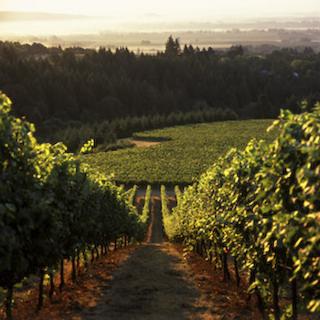 Evening Land
Evening Land
8. 2008 Evening Land La Source Pinot Noir Seven Springs Vineyard | Eola-Amity Hills, Oregon
n/a/ UK
Evening Land Vineyard was started over 5 years ago by Mark Tarlov, a customer of Larry Stone’s Rubicon restaurant (in which Francis Ford Coppola, Robert de Niro and Robin Williams were partners), since the mid-1990s in San Francisco, as well as a friend to many sommeliers in New York.
Says Larry: “Through our discussions and his beginning to drink some of the better wines from the West Coast, he came to believe that great pinot noir and chardonnay, Burgundian in sensitivity to terroir and place but not derivative of Burgundy or an imitation, could be made in particular micro-climates and terroirs in the western United States, specifically in Santa Rita Hills, Sonoma Coast and Willamette Valley”.
“This led him to acquire vineyards, farm and make wine in these areas, starting with the Occidental Vineyard in the Sonoma Coast. In addition to what he learned from me and other sommeliers, he also sought out the advice of Dominique Lafon and Sashi Moorman in planting and farming these vineyards and in making the wine. This has led additionally to the development of an Evening Land Vineyard venture in the Cote d'Or and Pouilly-Fuissé”
La Source in the Seven Springs Vineyard: the fruit is from vines that lie on an old pyroclastic flow of basalt that has a crystalline structure that lends a minerality to the wines, both the Chardonnay and the Pinot Noir.
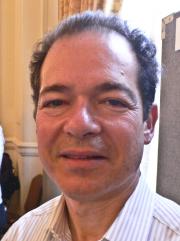 Larry Stone
Larry Stone
Analysis:
Vineyard: Clone/rootstock: 114, 115 and 777 on 3309 with old vines own-rooted Pommard . Planted in: 1984, 1988 and 1993 to 1996
Density: 453 and 873 vines per acre. Elevation: 350 to 650 feet
Slope: 6% to 12% Eastern slope. Row Orientation: East-west and North-South rows
Soil: Volcanic Basalt soils of the Nekkia series with some Jory
Vintage: GGD (April-October): 2,145
Rainfall (April-October): 208.8 mm
Budburst: April 5th to 10th
Bloom: June 17th to 23rd, 2009
Harvest: October 5th, 7th and 10th, 2009
Vinification: Harvest Parameters: 23.3 brix, 3.43pH and 6.2 g/L TA
Hand sorted and 100% de-stemmed by gravity into 3, 4 and 5 tons wood and cement open top fermenter.
Cold soaked at 58 degrees for 4-5 days
Spontaneous indigenous fermentation, gentle punch down 2X per day
Fermentation curve peaked at 32 degrees centigrade
Pressed after 18 days of vatting time
Barelling: all French oak with 25% new for 12 months
Bottled unfiltered and unfined.
0.02 g/L R.S., pH 3.60, TA of 5.6 g/l, Alc. 13.75%
Winemaker, Isabelle Meunier | Consulting Winemaker, Dominique Lafon
Tasting Note:
Lovely red berry fruit fragrance with a polished veneer of oak overlaying the aromas, the fruit is vivid, ripe and full-flavoured in the spectrum of mulberry and strawberry; it’s very juicy and delicately spiced with tobacco and rose petal, classic pinot noir smoothed and polished by gentle spicy oak , bringing a fine texture to the sweet savouriness of the fruit; overall a very nicely balanced wine.
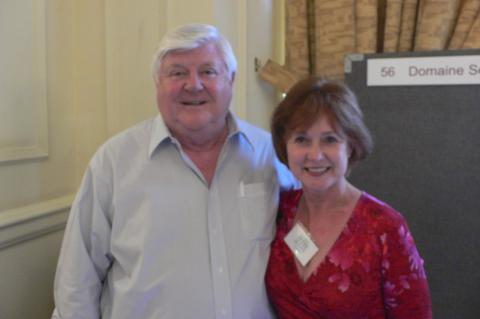 Ken and Grace Evenstad
Ken and Grace Evenstad
9. 2007 Domaine Serene, Evenstad Pinot Noir, Willamette Valley, Oregon
£47.50, SWIG
In 1989 a commitment to produce the world's best Pinot Noir led Ken and Grace Evenstad to Oregon where they founded Domaine Serene in the Dundee Hills located in the North Willamette Valley. Ken & Grace Evenstad purchased 42 acres on top of the Dundee Hills, in Yamhill County, Willamette Valley, Oregon and proceeded, over the next few years to add new vineyards to the estate.
Today, the Evenstad Estate Vineyard property totals 142 acres and consists of east, west and south-facing slopes, with extraordinary 360° views of the Cascade Mountains, the coastal ranges and the Willamette Valley. There are seven vineyards at the Estate, facing East, South and West at an elevation from 520 – 800 feet. Soils are ancient crumbling volcanic soils with a distinct red colour. There is also a Winery Hills estate and a Jerusalem Hill Estate (in Eola-Amity AVA).
In early 2000, construction began on the new five-level, gravity-flow winemaking facility atop the Dundee Hills, Oregon. Meanwhile, 2008 saw Domaine Serene’s flagship wine, the Evenstad Reserve.
Analysis:
A blend of Pommard, Dijon and Wedenswil clones sourced from two-thirds Dundee Hills, one-third Eola Hills.
Dry-farmed vineyards.
2007 was a cool, wet vintage
2.14 tons / acre yield.
18 months French oak of which two thirds was new.
Tasting Note:
Vivid, fine red fruits fragrance of mulberry and cherry; intense vivid pinot noir juiciness with subtle oak spicing and lovely freshness on the finish.
10. 2007 Domaine Drouhin Pinot Noir, Cuvée Laurène, Oregon
£34, D.Byrne, Berry Bros & Rudd, The Vineking
In 1987 Maison Drouhin bought a property in the Willamette Valley and built a 4-level gravity flow winery nestled into the Dundee Hills. Today, the estate totals 225 acres, including 124 planted. There are 111 acres of pinot noir. It was among the first in the new world with high-density plantings with spacing 1 metre x 1.3 metres – over 3100 plants per acre (3x-5x higher than the norm). It was also among the first in the US to plant Dijon clone pinot noir.
Staring with the 1992 vintage, th flagship Wine is Pinot Noir Cuvée Laurène, named for Véronique Drouhin’s daughter. Laurène is 100% estate fruit - a barrel selection; the wine is aged for 14 months in barrel, 18 months in bottle, and released 3 years after vintage
Says Véronique: “All of our Pinot Noir is hand picked into 25-pound totes, then hand sorted and destemmed in our four-level, gravity flow winery. We use only the ambient yeasts to begin fermentation, which is long and slow. Once in barrel, we use only 20% new oak in a given invtage, to allow the character of the wine, vintage and vineyard to show through. Our barrels are custom made for us in Burgundy, using oak from France’s best forests. Our goal is to produce Pinot Noirs with balance, elegance & finesse”.
“2007 will long be remembered for the lovely, graceful growing season that led up to a rather stressful harvest. Robert, Véronique and Philippe Drouhin literally spent three October weeks in a high-stakes chess match with the vineyards. In the end, a year’s worth of superb viticulture and a month of microscopic attention to detail allowed for a very successful vintage. It’s been easier before and since, but vignerons live for the challenge”.
Tasting Note:
Youthful, fresh and fragrant, there’s some complex characters and on the mid-palate a beguiling richness that’s not sweet, but rather pure red berry fruit flavours along with a firm structure of subtle tannins and beguiling fresh savoury acidity. This is a seductive wine both of concentration and finesse and with a backbone and structure that gives it the capacity to age for 10 years.
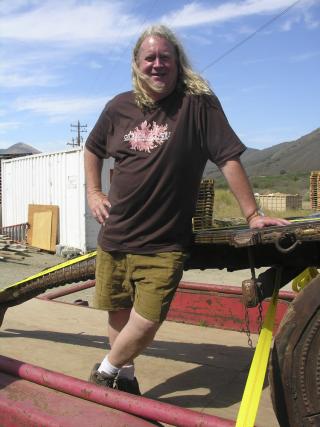 Jim Clendenen
Jim Clendenen
11. 2007 Isabelle Au Bon Climat Pinot Noir, Central Coast, California
£35, The Wine Society
During his “junior year abroad” in 1974, Jim Clendenen discovered life beyond tacos. Beginning with the 1978 harvest, he was assistant winemaker at Zaca Mesa Winery for three vintages. In 1981 his vision broadened with three harvests in one year as Jim worked crush and directed the harvest at wineries in Australia and France. Three harvests in one year confirmed his masochistic tendencies.
In 1982, Clendenen decided, along with now ex-partner Adam Tolmach, to start his own winery in leased quarters. Au Bon Climat has grown over its history to over 30,000 cases through careful re-investment from its own production. The winery has cultivated an international reputation for its Pinot Noir, Chardonnay, Pinot Blanc and Pinot Gris.
Jim Clendenen, the “Mind Behind” Au Bon Climat, is recognized worldwide for his classically styled wines (in addition to his Burgundian-focused ABC wines, Jim is also highly regarded for his Italian and other French varietals). In 1989 and 1990 Au Bon Climat was on Robert Parker’s short list of Best Wineries in the World, and in 1991 was selected by Oz Clark as one of fifty world-wide creators of Modern Classic Wines. In 2007, Jim was inducted into the James Beard Foundation’s “Who’s Who of Food and Beverage in America.”
Isabelle is the precocious, daughter of Jim Clendenen. As a result, Isabelle is the name Jim has given to the only pinot noir wine under his label that’s blended. The basis of this wine is usually Talley Rosemary's Vineyard, Sanford & Benedict Vineyard, new Dijon clone material from Bien Nacido Vineyard, and an occasional appearance from either Oregon or Mendocino. It’s a winery blend selected from the best barrels (François Frères French oak), the best clones, and the best vineyard sites available to him from the myriad of choices in the Au Bon Climat stable.
Tasting note:
There’s a lovely aromatic veneer of cedar spicy oak and vanilla with strawberry, while the palate itself is immensly seductively concentrated with spicy, dried rose petal undertones and a powerfully full-flavoured and explosiveness. At just 13.5% alcohol, it’s full-bodied but not overwhelmingly so and as a result a great California-meets-Burgundy style.
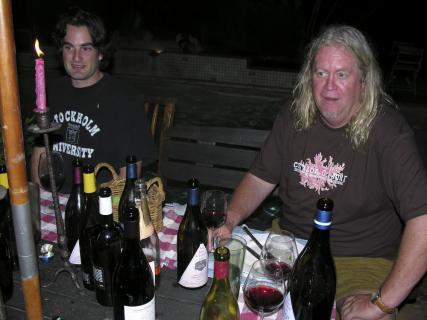 Jim Clendenen and magnum
Jim Clendenen and magnum

